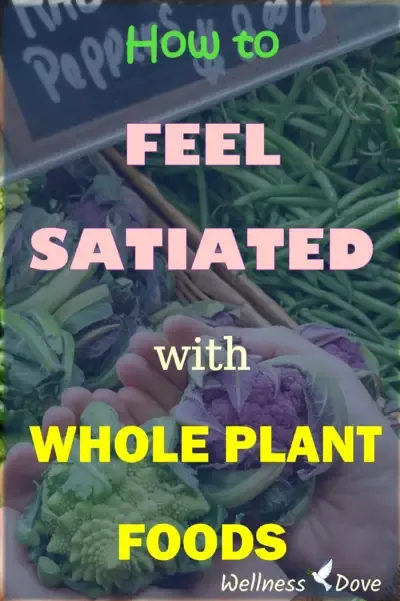People always seem to ask what do we eat, when we tell them we do not consume animal products.
And they are right to wonder.
So did we when we started to eat healthfully.
It was quite a challenge in the beginning and we thought that we might starve it we continued this way.
We did not, though. We found health.
So, here’s how to feel satiated on a whole food vegan diet (or simply jump to our recipe section).
Post Contents
Vegetables in moderation
It is a strange advice, we know.
Vegetables are the most micronutrient rich foods you can get.
They are extremely abundant in anti-oxidants, phytochemicals, vitamins, minerals. They have it all.
Vegetables are super important for vibrant health.
They lack one thing, though – calories.
At about 100 calories per pound, they will not keep you satiated for long.
If you were a gorilla the jungle and your actual job was to eat leaves all day long, you will be fine. You will actually be one of the strongest animals on Earth, as the gorilla is.
We do not eat leaves all day.
No question, we need those vitamins and nutrients in the vegetables.
Still, we need to eat more calories per volume of food.
That is why in the beginning we though we might starve.
Eating pure vegetable salads or cooked veggies was nowhere near as satiating as we need our food to be.
Fruits are treats
Fruits are sweet, tasty and not caloric enough for most people.
At about 200-300 calories per pound, they will satiate you better than veggies.
But you need to eat a large volume of fruits, probably even blend or juice them to get enough energy.
Undeniably, you could but it is not practically possible.
Fruits make for the most practical snacks, though!
Eat what people used to eat
People used to eat starchy vegetables, legumes and whole grains.
At about 500-600 calories/pound, there foods will provide enough oomph to keep you energetic throughout the day.
These foods are rich in complex carbohydrates that digest slowly over time, keeping your energy levels constant.
Check our our understanding carbohydrates section to see how complex carbs work.
Legumes, whole grains and starchy vegetables might not sound like much at first but when you think about it, there are so many varieties.
Chickpeas, split peas, lentils, kidney beans, white beans, pinto beans, navy beans, even soy beans…
Oats, corn, brown rice, quinoa, buckwheat, einkorn, spelt, amaranth…
And lets not forget the humble potato and sweet potato which has historically fed much of South America and Japan.
[su_pullquote align=”right”]Our meal ideas![/su_pullquote]
These are satiating and nutritious foods.
They provide calories in the healthiest way possible and are not difficult to cook.
Nuts and seeds as a side dish
Nuts and seeds are healthy, that is unquestionable.
They also taste great.
That is because nuts and seeds are very calorie dense – 2500 calories/pound, most of which is fat.
Healthy, brain and heart supporting fat which, however, is still fat.
And fat can make us fat quite quickly.
More importantly, fat is not our body’s primary source of energy. Carbohydrates are.
So, you might eat, say, 500 calories of nuts but you won’t feel as satiated and energetic as if you ate 500 calories of beans.
Also, 500 calories of nuts won’t fill the stomach nearly well enough for you to feel full. The beans will.
To feel full, you must fill the stomach and provide enough carbohydrate to run the brain.
That is why nuts make for a perfect salad dressing, sauce or a side dish.
Oils and sugars don’t count
We are talking about Whole Plant Foods here.
Oil and sugars are the ultimate processed food.
They are super unhealthy, cause cause high insulin, blood viscosity, heart disease, brain problems, obesity…
Many vegans will eat salads covered with oily dressings, fruit bars with extra sugars and delicious cakes with both oils and sugars.
This is not the way to be healthy.
That said, we do not condemn desserts but you can make them with no oil and very little sugar (check out our dessert recipes).
Summing up
Feeling satiated on a whole plant food diet is easy.
Base your meals on starchy vegetables (potatoes, sweet potatoes), legumes and whole grains.
Add some nuts/seeds on the side, in the sauces or as a dressing.
Or simply make filling salads with beans/grains inside.
Add some fruit as a snack.
Simple and delicious.




hallo i am from denmark and like what i see . i am vegan women on 58 years old and no gluten no olie er am slim because i live like this waye and love frut. .but have hypetension and i am low in natrium . i like your weigt loss and is is alså good for higher blodpress ? and can i translate if i buye 21 dags weigt loss program ??
best regards Pia Holleran
Thank you so much for sharing all your research, knowledge and ideas! I’ve been a vegetarian for 30 years whose instinct has always been that potatoes, whole grains, nuts and seeds were an essential part of a plant-based diet and didn’t deserve their sometimes negative reputation as “fattening.” During the Keto Diet craze, so many people I knew were subsisting on meat and non-starchy vegetables. Many were losing weight, but their diets seemed so unhealthy.
Even I fell for some of the hype, trying to cut down on carbs by adding more vegetables to my meals. I felt starved! Adding products like yogurt, cheese, and oil didn’t seem like the answer to be satiated either. I’ve flirted with becoming vegan many times since I don’t eat a lot of dairy or eggs, but most of the vegan recipes I came across were either complicated or relied too much on less-than healthy ingredients like pasta, flour, sugar and oil. I recently joined the Forks Over Knives Facebook group and even bought a popular whole-foods-plant-based cookbook people were talking about. The first 5 things I made from it were a little time-consuming for my taste, but I wanted to try. While healthy, none of these recipes tasted good. Someone recommended your website in the Facebook group so I thought I’d take a look. The recipes were easy enough to try so I did. First, I made the Einkorn bread (my local Hyvee had the flour) in my bread maker. It’s delicious! Then I tried the falafel balls and sauce, which were great! Next I made the sweet potato quinoa burgers and recommended sauce, which were also yummy! I’ve printed off about 20 of your recipes so far and am excited to try them all! Everything you say makes so much sense. I really appreciate your sharing what you’ve learned!
Hi Jennifer,
Thank you so much for the kind words! We are so happy that you like our recipes and they make the whole food, plant-based lifestyle easy for you!
When we first started eating whole plant food, we struggled to stay satiated. We also found many of the recipes we tried to be too much work but didn’t keep us full for long. That’s why we created our website and it makes us extremely happy to know that we’ve helped yet another person stay plant-based.
We completely understand why you were tempted by the keto diet – it mimics fasting (which is healthy when done properly and short-term) and people achieve great short-term results but the long-term consequences for our health aren’t good at all. If you want to read more, you can check out this article: https://wellnessdove.com/why-keto-works-but-you-shouldnt-do-it/
Also, if you have any questions about health and thriving on a whole plant foods diet, feel free to ask us in the comments or send us an email. We are always happy to help!